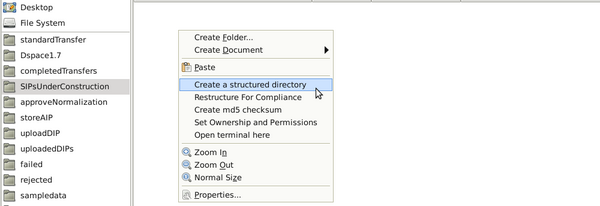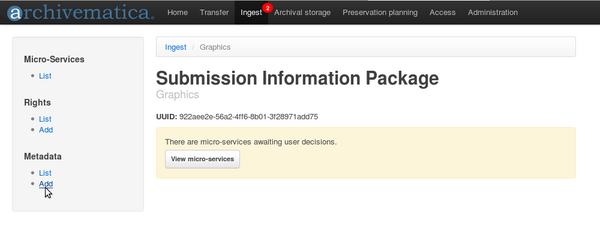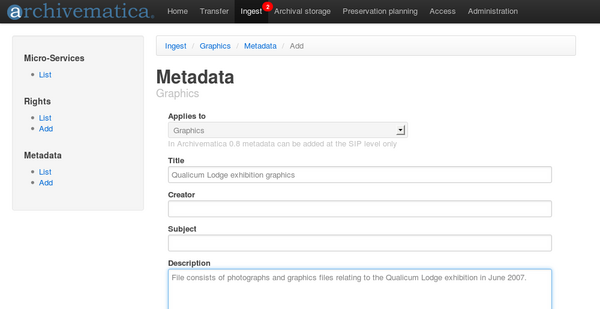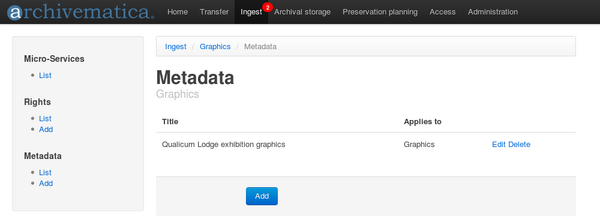UM ingest
Main Page > Documentation > User manual > User manual 0.8 > Ingest
General description
During ingest, digital objects are packaged into SIPs and run through several micro-services, including normalization, packaging into an AIP and generation of a DIP.
Create one or more SIP(s)
- Process one or more transfers as described in Transfer.
- While still viewing the transfer tab you should see a bell icon next to the transfer. The micro-service related to the bell is "Create SIP(s)".
- Choose one of three options for creating a SIP (or reject the transfer if desired, to stop all processing and move the transfer to the rejected folder in the file browser).
Option 1: Create single SIP and continue processing
This will create a single SIP from the transfer and move it through the initial micro-services to the normalization step.
- Once you have selected "Create single SIP and continue processing", click on the Ingest tab.
- The SIP will be running through a number of micro-services. Wait until it reaches "Normalize" and a bell icon appears.
- To add descriptive metadata, see Metadata, below.
- For selecting a normalization option, see Normalization, below.
Option 2: Create single SIP
This will create a single SIP from the transfer and allow the user to re-organize or delete digital objects if desired. This is useful if there has been no appraisal on the objects prior to processing in Archivematica. Note that the original order of the transfer is maintained in the transfer METS file, a copy of which is automatically added to the SIP.
- Once you have selected "Create single SIP", click on the Ingest tab.
- The SIP will appear in the dashboard with a bell icon next to it. In the file browser, open SIPsUnderConstruction using the shortcut in the left panel. Your SIP will be in this directory.
- Open the SIP, navigate to the objects directory and delete and re-organize the objects as desired.
- Return to the dashboard. Add descriptive metadata if desired (see Metadata, below). In the Actions drop-down menu select "SIP creation complete".
- Wait until it reaches "Normalize" and a bell icon appears.
- If you haven't already done so, you can add descriptive metadata at this point. See Metadata, below.
- For selecting a normalization option, see Normalization, below.
Option 3: Manual SIP creation
This option allows the user to break one transfer into more than one SIP, or to create one or more SIPs from more than one transfer. The permitted relationships between transfers and SIPs in Archivematica are completely flexible:
- One transfer --> one SIP
- One transfer --> multiple SIPs
- Multiple transfers --> one SIP
- Multiple transfers --> multiple SIPs
The user can also re-organize and delete objects within the SIP(s). Note that the original order of the transfer is maintained in the transfer METS file, a copy of which is automatically added to each SIP.
- Once you have selected "Manual SIP creation", open the file browser and navigate to SIPsUnderConstruction using the shortcut in the left panel.
- Hover your cursor over the empty right-hand panel, right-click and select "Create a structured directory".
- Follow the steps to create the directory and repeat the process until you have the desired number of SIPs.
- Navigate to completedTransfers using the shortcut in the left-hand panel. Your completed transfer will be in that directory.
- Open the transfer and cut and paste digital objects from its objects directory into the objects directories of the SIPs created in steps 1-3. Note that you must cut and paste, not copy and paste. Archivematica doesn't let you accidentally place the same digital object from a transfer into more than one SIP.
- Return to the dashboard and open the Ingest tab.
- Your SIPs will appear in the dashboard with bell icons next to them.
Add metadata
- Click anywhere on the grey background of a SIP to add Dublin Core metadata.
- This will take you to the SIP detail panel. On the left-hand side, under metadata click Add.
- Add metadata as desired and save it by clicking the Save button at the bottom of the screen. Note that in Archivematica 0.8 you can only add metadata at the SIP level. If you would like to add metadata to a digital object, you will need to do that once the object has been uploaded to your access system.
- When you click Save, you will see the metadata entry in the list page. To edit it further, click Edit on the right-hand side.
- Return to the ingest tab to continue processing the SIP.
Normalize
In the transfer you have just created, navigate to the /metadata/submissionDocumentation folder and add files if desired. These files could be donor agreements, transfer forms, copyright agreements and any correspondence or other documentation relating to the transfer. Any SIPs subsequently made from this transfer will automatically contain copies of this documentation.










